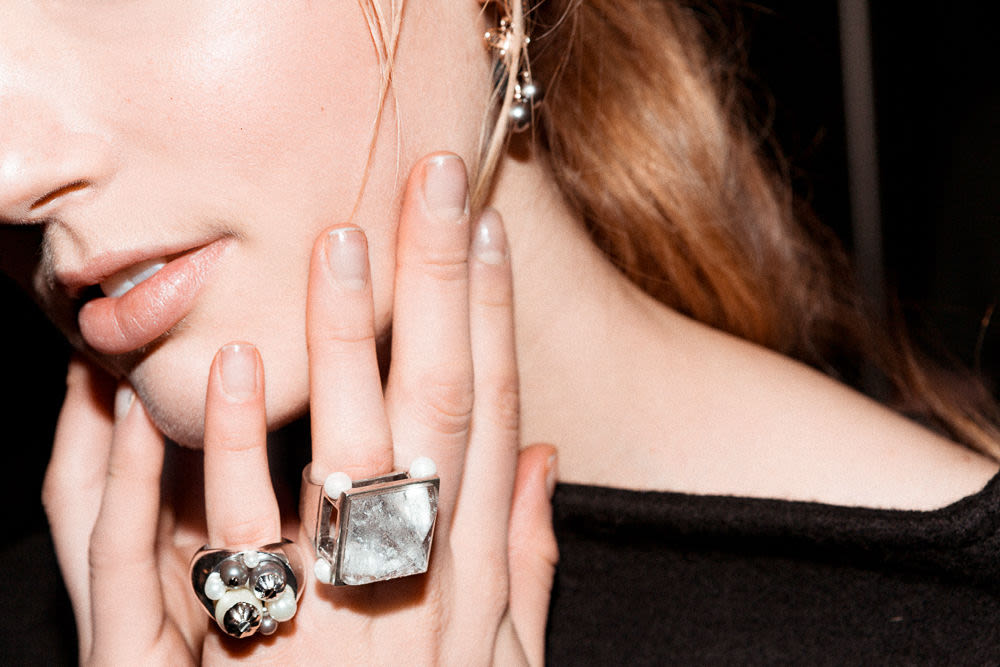They say the eyes are the windows to the soul—but your nails are the windows to your life. If your nails are bitten to the quick, maybe you’re a surgeon or trial lawyer, or something equally high-stress. If they’re polish-free, maybe you’re a chef, or do something with your hands where color would be distracting. In her Top Shelf, Gachot Studios Principal Christine Gachot told us, “I don’t wear bright nail polish because I’m referring to drawings often.” And Natasha Pickowicz said, “I don’t wear fingernail polish—I work in a restaurant!”
Your hands do so much for you (and speak for you!)—isn’t it time you did something nice for them? Luckily, with all the at-home manicure tools on the market, you don’t need to pay for weekly salon visits to maintain good nail health. You’re basically a pro! But to figure out where you might be going wrong, we spoke to a couple real ones: professional manicurist Lauren Michelle Pires and Sarah Gibson Tuttle, founder of nail care brand Olive and June.
Good nails start from the inside
Your skin and your nails aren’t too different—both are made up of a protein called keratin, and both are influenced by your diet and lifestyle. Actually, what you put into your body has more of an effect on your nail health than you might think. “This may not sound like an obvious one,” says Lauren, “but when your immune system and health aren't at their best game, your hair and nails grow at a much slower rate. Our nails need a balanced diet in order to keep growing, just like our bodies.” If your nails have ridges, don’t file them away—they could be a sign of a vitamin deficiency. And if you’re noticing the texture of your nails to be dry and brittle, you might not be drinking enough water. Lauren adds, “I find my nails get a little brittle when I’m not hydrated—I try for eight glasses a day. It’s also good for your skin, so it’s a no-brainer.”
Keep your cuticles clean
Calling all anxious cuticle pickers! If you take care of them regularly, there will be no stringy cuticles to tug, pluck, or gnaw on. As to the preferred method of cuticle taming? Both Gibson Tuttle and Pires agree: push them back, don’t cut them. “Trimming your cuticles can create more hangnails, jagged edges, and even cause infection,” says Gibson Tuttle. She recommends pushing them back every morning, every night, or both to keep new growth at bay. To do it at home, you can use a cuticle softening agent and gently push any excess skin down to the base of your nail. Be careful not to push too hard—those white spots you’ve probably noticed on your nails at one point or another are actually from trauma to the nail. They’re called leukonychia. Because nails grow slowly, you won’t see them immediately—actually, by the time they show up, you’ll probably forget what caused them altogether. If you’re worried about a heavy hand, follow Pires’ advice and do it in the shower. “A good trick I’ve learned is that you can push your cuticles back in the shower with some hair conditioner,” she says.
And feed them with oil
To make your nails look cleaner in a pinch, both Gibson Tuttle and Pires recommend having a cuticle oil on hand. If you’re consistent with it, the cuticle oil long game will help your nails grow stronger, too. “My number one tip is to apply cuticle serum two times a day,” says Gibson Tuttle. She adds, “Not only will it make your nails look like you just walked out of a salon five minutes ago, but it will also encourage healthy nail growth.” Think of it as the nail equivalent of giving your scalp a little extra TLC for shinier, thicker hair. Pires explains further: “By using cuticle oil, you’re feeding the area where the new nail grows out from, also called the nail matrix,” she says. Olive and June makes its own, or you could take Pires’ recommendation and try one from Sally Hansen. It’s packed with vitamin E, an antioxidant with anti-inflammatory properties. Then, she instructs, put a drop on each cuticle and massage it in. “If you do this religiously, they’ll grow out stronger.”
Don’t pick your polish
We asked Pires about her clients’ number one concern. Her answer?: “Thin nails from picking off gels! Each time you peel off gels you are damaging your nail’s natural layers—your nail plate is only made up of three.” Gibson Tuttle adds, “Picking gel, acrylics, or regular polish will damage your nail plate and make it really hard for future manicures to properly stick.” Just how permanent is the damage? Pires says it could take around six months for nails made thin from picking to fully grow out. “Set aside 60 minutes for a professional salon removal for gels. It’s a no brainer.” And if you haven’t fully committed to gels, a designated weekly at-home mani will curb any instinct to chip away at old polish. Gibson Tuttle says, “Just make sure to take old polish off—if having your nails painted makes you feel good and ready to take on the world, you can make it a complete mani, too.”
Most importantly: Have patience!
While a good manicure can do wonders, it won’t fix every problem instantly. “Nails won't improve overnight,” says Pires. “Patience and persistence equal perfection.” If you need us, we’ll be massaging our nail beds until winter.
Photos via ITG

